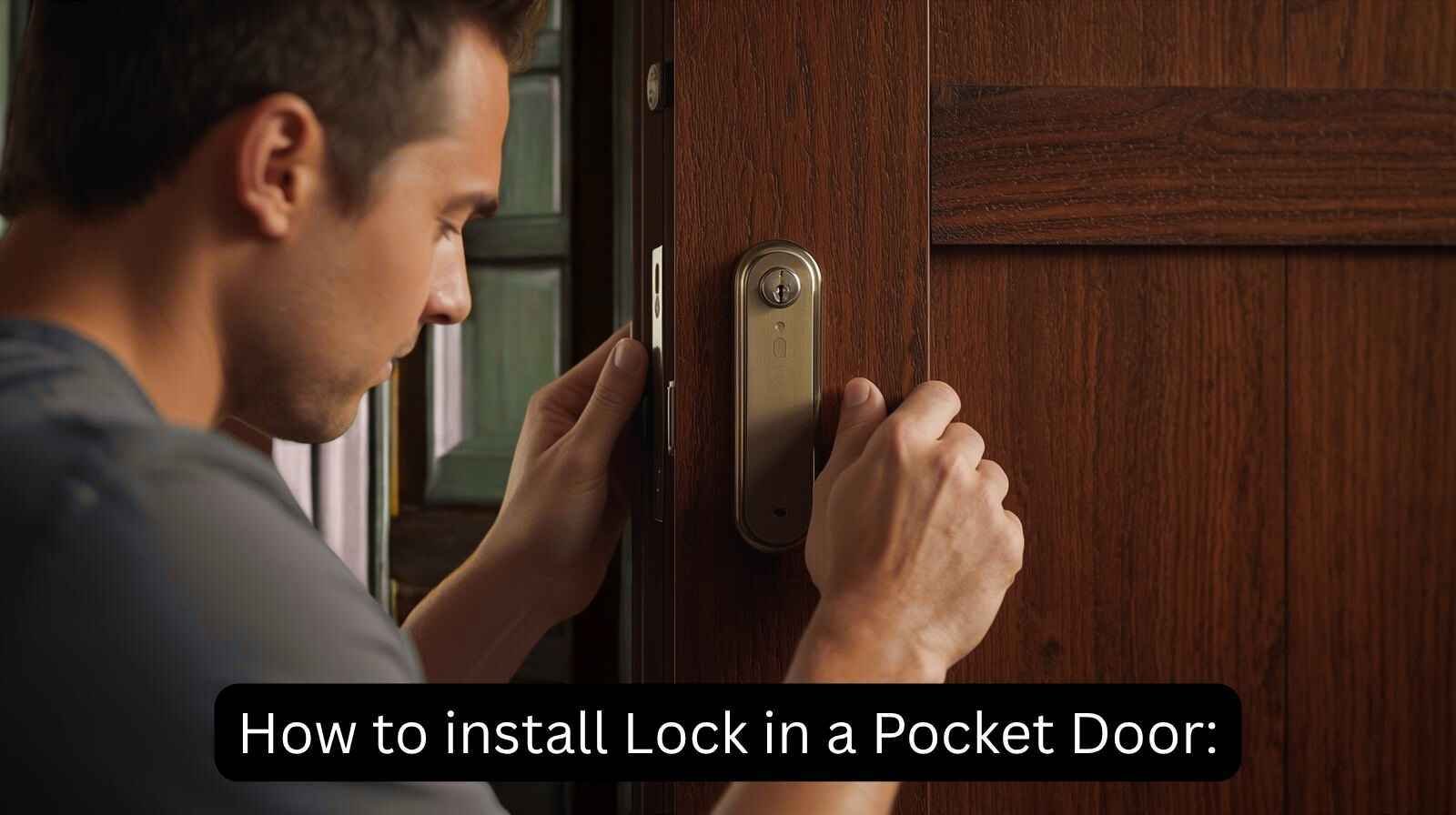What Is a Pocket Door?
A pocket door is a type of sliding door that disappears into the wall when opened. It does not swing like a traditional door, making it a space-efficient solution, especially for smaller rooms or tight spaces. These doors are often used in bathrooms, closets, or bedrooms where maximizing space is important. Whether a pocket door is installed in a bathroom, bedroom, or hallway, understanding how to lock a pocket door is essential for maintaining privacy and security.
Because pocket doors slide, they are not usually fitted with traditional locks. Therefore, for security or privacy, it is important to know how to lock a pocket door. This article provides a detailed review of the process of installing a pocket door lock.
Why Should You Lock a Pocket Door?
Before you know how to lock a pocket door, you should know why to lock a pocket door. Locking a pocket door can serve several purposes:
- Privacy: The most common reason to lock a pocket door is to ensure privacy, especially in bathrooms, bedrooms, or home offices. Privacy locks are simple to install and can be locked or unlocked easily from the inside.
- Security: In some rooms, such as home offices, storage rooms, or rooms with valuables, locking the door adds an extra layer of security to prevent unauthorized access.
- Safety: If you have young children or pets, locking certain rooms can be an effective way to keep them out of areas where they might get into trouble or danger.
Types of Locks for Pocket Doors
Before knowing how to lock a pocket door, it is important to understand which type of lock you need. When installing a lock, it’s essential to be aware of the different types available for pocket doors. There are several options depending on your needs, ranging from simple privacy locks to more secure keyed locks. Here are some of the most common types:
- Privacy Locks: These are the most common locks for bathrooms and bedrooms. They are designed to provide privacy and can be locked from the inside. These locks typically come with a release feature on the outside, allowing someone to unlock the door in case of an emergency.
- Keyed Locks: Keyed locks are more secure than privacy locks. They require a key to lock and unlock the door. These locks are often used for doors leading to offices or rooms that require restricted access.
- Passage Locks: These are non-locking door hardware used for spaces where security and privacy are not a concern. Passage locks are useful for closets or hallway doors.
- Surface-Mounted Locks: These locks are mounted on the surface of the door, making them easier to install. Surface-mounted locks don’t require any drilling through the door, which can be ideal for retrofit installations.
- Electronic Locks: Some pocket doors can be fitted with electronic locks. These locks use codes, keypads, or even biometric recognition to provide a more high-tech security option. However, electronic locks are usually more expensive and require professional installation.
Step-by-Step Guide on How to Lock a Pocket Door or Install It
How to lock a pocket door or install it? Installing a lock on a pocket door may seem intimidating, but with the right tools and a little patience, it can be done easily. Here’s a detailed guide on how to lock a pocket door.
Step 1: Choose the Right Lock
Before getting started, it’s important to choose the right type of lock. You’ll want to pick a lock that suits your needs in terms of privacy, security, and convenience.
- For a bathroom or bedroom, a simple privacy lock will work.
- For a home office or storage room, a keyed lock provides higher security.
Ensure that the lock you choose is compatible with pocket doors. Some locks are specifically designed for pocket doors, so be sure to look for those to make the installation process easier.
Step 2: Measure and Mark the Lock’s Position
Once you’ve chosen your lock, it’s time to install it. The first step is to measure and mark the areas where you’ll need to drill.
- Determine the Height: Most locks are installed about 36 inches above the floor, which is a typical height for easy access. Measure from the floor and mark the spot where the lock mechanism will go. This mark will guide where you’ll drill.
- Mark the Doorframe: Don’t forget to mark where the strike plate (the part that holds the latch) will be installed on the doorframe. This part needs to align perfectly with the lock for it to function correctly.
Step 3: Drill the Necessary Holes
Now that everything is marked, it’s time to drill. This is where you’ll need to use a power drill and a bit that fits the lock mechanism. Be sure to drill carefully and slowly, as pocket doors are often made from softer wood or composite materials that can splinter easily.
- Drill the Hole for the Lock: Start by drilling the hole in the door itself. The hole should be slightly larger than the lock’s body so that it fits snugly inside.
- Drill the Hole for the Strike Plate: Next, you’ll need to drill a hole in the doorframe where the latch will lock into place. This hole should align perfectly with the lock on the door, so take care to make sure they are positioned correctly.
Step 4: Install the Lock Mechanism
With the holes drilled, it’s time to install the lock. The process will vary slightly depending on the type of lock you’re using, but the general idea is the same.
- Place the Lock Mechanism in the Hole: Insert the lock mechanism into the hole in the door. Most locks come with screws that you’ll use to secure the lock into place.
- Tighten the Screws: Tighten the screws gently, making sure the lock is held securely but not too tight to avoid damaging the door. Test the lock by turning the knob or lever to ensure the latch moves smoothly.
Step 5: Install the Strike Plate
The strike plate is the part of the lock system that the latch clicks into when the door is closed. This part ensures the door stays securely locked.
- Align the Strike Plate: Position the strike plate on the doorframe so that it lines up with the latch. Mark the spot where the screws will go.
- Screw the Strike Plate into Place: Use screws to attach the strike plate to the doorframe. Again, make sure everything is aligned properly for the latch to engage easily.
Step 6: Test the Lock
After everything is installed, it’s time to test the lock. Open and close the door a few times to make sure the lock engages and disengages smoothly. Try locking and unlocking the door several times to ensure the mechanism works properly.
If the lock doesn’t engage correctly, you may need to adjust the strike plate or the lock itself. If the door doesn’t latch properly, try loosening or repositioning the screws to make sure everything aligns perfectly.
Alternative Methods of How to lock a pocket door
IIf you don’t want to install a permanent lock or if you’re looking for a temporary solution, there are other methods for how to lock a pocket door.
- Hook-and-Eye Latch: This is an inexpensive option. You can attach a hook to the door and an eye to the doorframe. When the hook is inserted into the eye, the door will be secured.
- Portable Locking Devices: Several portable devices are available that can be used to lock sliding doors without permanent installation. These are easy to use and can be removed when not needed.
- Slide Bolt: A simple slide bolt can be installed on the edge of the door. This is a good solution for keeping the door closed without needing a traditional lock.
Troubleshooting Common Issues
Sometimes things don’t go as planned during installation. Here are some common issues you may encounter when learning how to lock a pocket door and how to fix them:
- The Lock Doesn’t Engage Properly: This is usually due to misalignment between the lock and strike plate. Adjust the strike plate or lock mechanism to make sure the latch fits into the strike plate smoothly.
- The Lock Is Sticking: If the lock is difficult to turn, try using a lubricant like WD-40 to reduce friction. A small amount on the moving parts can help the lock work more smoothly.
- The Lock Is Loose: If your lock feels loose, it might be because the screws weren’t tightened enough. Simply tighten the screws again to make the lock more secure.
Frequently Asked Questions (FAQs)
Q1: Can I install a lock on any pocket door?
A1: Most pocket doors can be fitted with a lock, but it’s important to choose a lock that is designed for pocket doors. Some locks may require modifications to the door or frame to work properly.
Q2: Do I need to hire a professional to install a lock on my pocket door?
A2: If you are comfortable using basic tools and following instructions, you can install a pocket door lock yourself. However, if you’re not confident with tools, hiring a professional might be a better option.
Q3: Can I lock a pocket door from the outside?
A3: Yes, some locks are designed to be operated from both sides of the door. If you want to be able to lock a pocket door from the outside, choose a lock that includes this feature.
Q4: Are there locks that don’t require drilling?
A4: Yes, surface-mounted locks and portable locking devices can be installed without drilling into the pocket door.
Q5: How do I maintain the lock on my pocket door?
A5: To maintain your lock, keep it clean and lubricated. Periodically check for any wear or damage, and replace parts if necessary.
Q6: How to lock a pocket door?
A6: To know how to lock a pocket door, you need to read this article carefully, and you will find out how to lock a pocket door.
Conclusion
Installing a lock on a pocket door can be an easy and rewarding project that enhances both the privacy and security of your home. Whether you choose a simple privacy lock or a more secure keyed lock, following this detailed guide will ensure you get the job done right. A locked pocket door is an effective way to keep your personal spaces safe and secure.
Hope this article helps you to know how to lock a pocket door , and if you want to know about pocket doors’ Benefits, Hardware, kit, and more, go to daily life ways.








